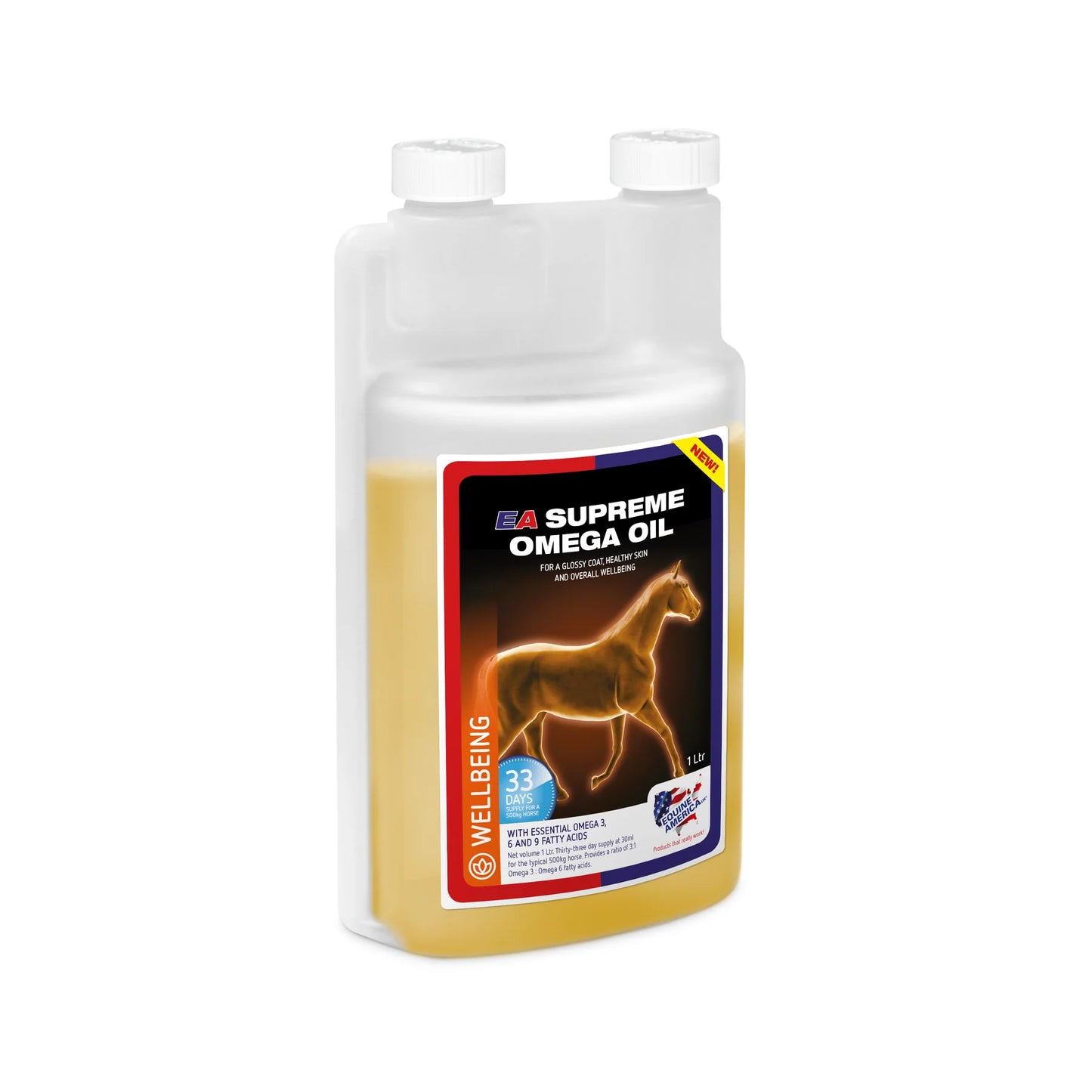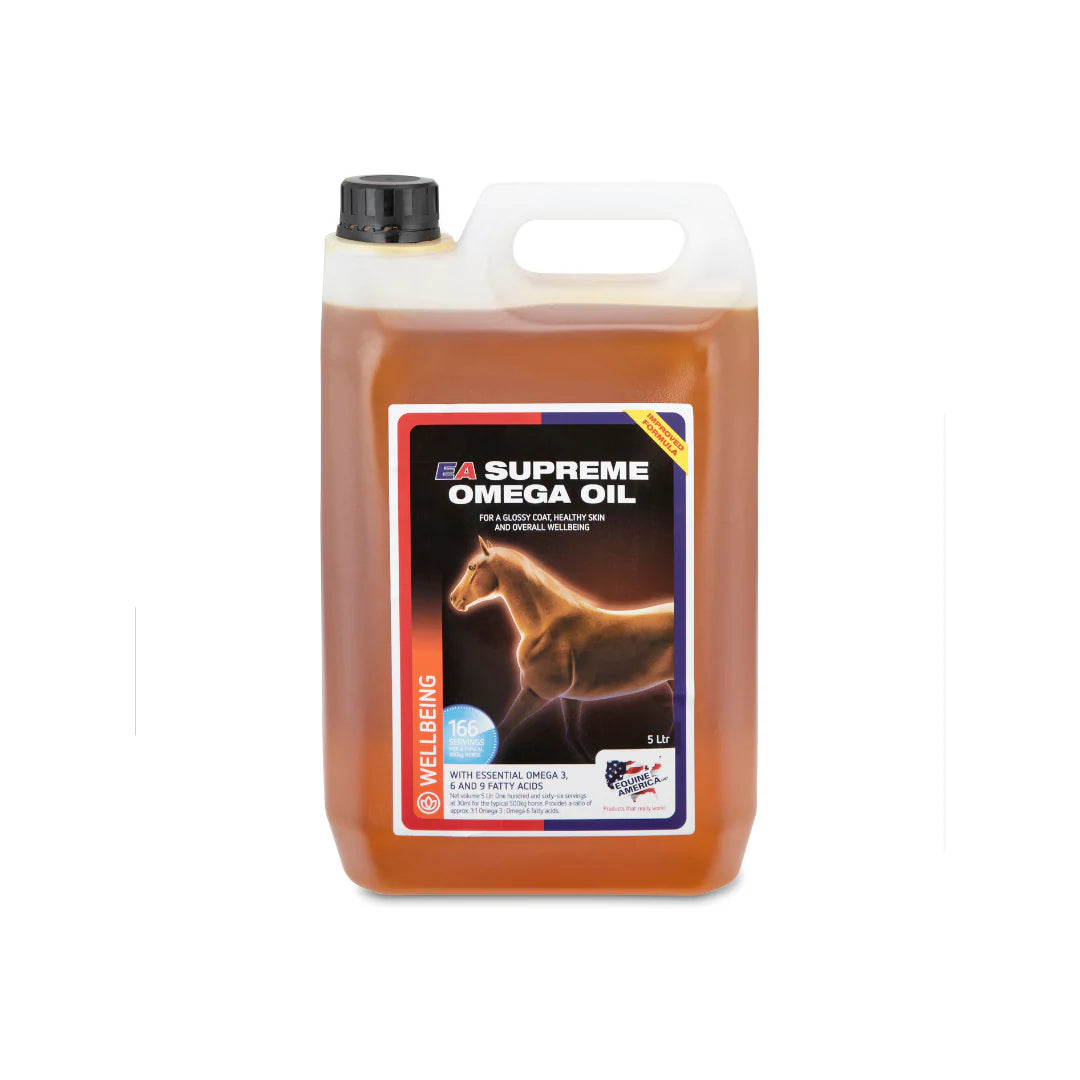Equine America
EA Supreme Omega Oil
EA Supreme Omega Oil
Couldn't load pickup availability
Why is Omega 3 important in equine nutrition?
Today, adding oil to the diet of horses and ponies is a widely accepted practice to provide extra calories without increasing starch or sugar intake. Furthermore, oil is recognized as a contributing factor to a shiny coat and healthy skin.
However, in recent years, there has been increasing interest in the type of oil and its fatty acid composition, particularly polyunsaturated fatty acids (PUFAs) . The focus is on two key groups that have important implications for horse health:
-
Omega 3 fatty acids , derived from ALA (alpha-linolenic acid) , which the horse can convert into EPA (eicosapentaenoic acid) and DHA (docosahexaenoic acid) if ALA is present in the diet.
-
Omega 6 fatty acids , which come from LA (linoleic acid) .
Both omega 3 and omega 6 perform essential functions in the horse's body, such as:
-
Joint health
-
Hoof health
-
Reproduction
-
Immune system
-
Endocrine (hormonal) function
-
Respiratory system
-
Neurological function
-
Condition of skin and coat
Omega-6s are essential because they promote the production of substances involved in the initial inflammatory response, which is essential for activating immune defenses after an injury or illness. However, this pro-inflammatory effect can be excessive if there is an imbalance in the diet. Oils such as corn, soybean, and sunflower are rich in Omega-6s.
Omega-3s , for their part, not only participate in key metabolic processes but also help the horse modulate its own anti-inflammatory response. Oils rich in Omega-3s include linseed oil and fish oil. The latter directly provides EPA and DHA, while flaxseed provides ALA, which the horse converts into EPA and DHA.
The ideal balance between Omega 3 and Omega 6
The natural diet of free-range horses, based on fresh forage, has a higher content of Omega 3 than Omega 6, with an estimated ratio of between 3:1 and 4:1 in favor of Omega 3 when the grass is growing.
In contrast, modern sport horses are typically fed grains and dry forages (hay or haylage), which are higher in Omega 6 and low in Omega 3 due to the drying of the grass. This leads to an excess of pro-inflammatory fats and an Omega 3 deficiency, with a potential negative impact on health and performance.
What does EA Supreme Omega Oil provide?
To compensate for this imbalance, it is essential to supplement the diet with sources of Omega 3, especially in:
-
Horses in intense work
-
Broodmares and young foals
-
Older horses
-
Horses with limited access to pasture
Although fish oils have more EPA and DHA than plant sources, they present palatability and environmental sustainability issues.
That's why EA Supreme Omega Oil is formulated with flaxseed oil , a rich source of ALA, which horses can convert into EPA and DHA. Although the conversion rate is not fully known, clear benefits are seen in most horses when given 30 to 60 ml of this omega-3-rich supplement daily .
Share


Collapsible content
Product description
Why is Omega 3 important in equine nutrition?
Today, adding oil to the diet of horses and ponies is a widely accepted practice to provide extra calories without increasing starch or sugar intake. Furthermore, oil is recognized as contributing to a shiny coat and healthy skin.
However, in recent years, there has been increasing interest in the type of oil and its fatty acid composition, especially polyunsaturated fatty acids (PUFAs). The focus is on two key groups that have important implications for horse health:
Omega 3 fatty acids, derived from ALA (alpha-linolenic acid), which the horse can convert into EPA (eicosapentaenoic acid) and DHA (docosahexaenoic acid) if ALA is present in the diet.
Omega 6 fatty acids, which come from LA (linoleic acid).
Both omega 3 and omega 6 perform essential functions in the horse's body, such as:
Joint health
Hoof health
Reproduction
Immune system
Endocrine (hormonal) function
Respiratory system
Neurological function
Condition of skin and coat
Omega-6s are essential because they promote the production of substances involved in the initial inflammatory response, which is essential for activating immune defenses after an injury or illness. However, this pro-inflammatory effect can be excessive if there is an imbalance in the diet. Oils such as corn, soybean, and sunflower are rich in Omega-6s.
Omega-3s, for their part, not only participate in key metabolic processes but also help the horse modulate its own anti-inflammatory response. Oils rich in Omega-3s include linseed oil and fish oil. The latter directly provides EPA and DHA, while flaxseed provides ALA, which the horse converts into EPA and DHA.
The ideal balance between Omega 3 and Omega 6
The natural diet of free-range horses, based on fresh forage, has a higher content of Omega 3 than Omega 6, with an estimated ratio of between 3:1 and 4:1 in favor of Omega 3 when the grass is growing.
In contrast, modern sport horses are typically fed grains and dry forages (hay or haylage), which are higher in Omega 6 and low in Omega 3 due to the drying of the grass. This leads to an excess of pro-inflammatory fats and an Omega 3 deficiency, with a potential negative impact on health and performance.
What does EA Supreme Omega Oil provide?
To compensate for this imbalance, it is essential to supplement the diet with sources of Omega 3, especially in:
Horses in intense work
Broodmares and young foals
Older horses
Horses with limited access to pasture
Although fish oils have more EPA and DHA than plant sources, they present palatability and environmental sustainability issues.
That's why EA Supreme Omega Oil is formulated with flaxseed oil, a rich source of ALA, which horses can convert into EPA and DHA. Although the conversion rate is not fully known, clear benefits are seen in most horses when given 30 to 60 ml of this omega-3-rich supplement daily.
Ingredients and Nutrition
Cold-pressed linseed oil contains more than 4 times more Omega 3 than Omega 6.
Key ingredients per maintenance dose (30 ml):
Linseed oil (flax): 30 ml
Omega 3 fatty acids: 15.7 g
Omega 6 fatty acids: 4.2 g
Omega 3 : Omega 6 ratio → 3.7 : 1
Analytical components:
Crude protein: <1.0%
Crude fat: 99.0%
Crude fiber: <1.0%
Crude ash: <1.0%
Sodium: <1.0%
Instructions for use
How to use:
For a 500 kg horse: administer between 30 and 60 ml per day.
If necessary, the dose can be increased to 100 ml per day.
Important:
If feeding a high amount of EA Supreme Omega Oil, it is essential to ensure that the rest of the diet provides enough vitamin E to meet the horse's needs.
For more information or advice, please contact us.

